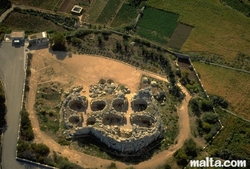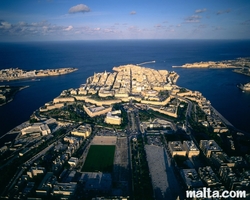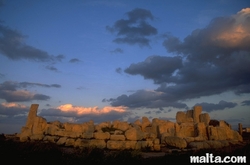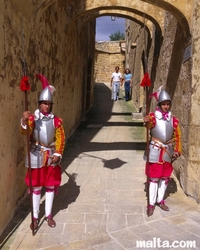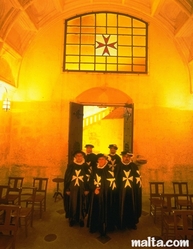The culture of Malta throughout the millenia
The culture of prehistoric Malta
Malta was first inhabited by Sicani who arrived from nearby Sicily around 5000BC. They grew cereals, raised livestock and, as other ancient Mediterranean cultures, formed a cult that revolved around fertility, represented by statues of unusually large proportions. These people built megalithic temples, such as Mnajdra, Ggantija and Hagar Qim (4000–2500 BC) - considered to be the oldest standing stone structures in the world. Not much is known about these temple builders; however there is some evidence that their rituals included sacrificing animals. This culture disappeared from the Maltese Islands around 2500 BC and was replaced by people of the Bronze Age, a culture that is known to have cremated its dead and introduced smaller megalithic structures to Malta, called dolmens.
Semitic influence
Malta was inhabited by the Phoenicians from around 700 BC who exploited the shelter of Malta’s harbours. By 480BC, as Carthage was growing its empire in the Western Mediterranean, Malta became a Punic colony. Exposure to semitic influences continued to an during the 268-year rule of the Knights of St. John, in part because of trade, but mainly because of the large numbers of slaves present in Malta during the 17th and 18th centuries. Dramatic incidents related to piracy and slavery remain with us till today, as reflected in Maltese folklore, superstitions, beliefs, sayings and in the Maltese literature, with works such as Inez Farrug written by Anton Manwel Caruana in 1889 (1889) and the traditional ballad of l-Gharusa tal-Mosta, which narrates the kidnap of a Maltese bride by Turkish pirates.
Latin European influence
From 218BC to 395AD, Malta was under the Romans, initially under the control of Sicily. The islands were later given the status of Roman municipium, having the power to decide on internal affairs. During this time, St. Paul was shipwrecked on the Maltese Islands and introduced Christianity. The Roman period is notable for the arrival of many noble Roman families, whose progeny remain part of the Maltese society till this very day. With the division of the Roman Empire in 395, Malta was given to the eastern portion ruled from Constantinople and this new colonization introduced Greek families to the Maltese community bringing with them various superstitions, proverbs, and traditions that still exist within Maltese culture today.
The Normans and Spanish
With the Norman rule, many Sicilians and Italian migrated to Malta, making Sicilian the sole written language of Malta, and since then, a good number of Sicilian and Italian words were adopted into the Maltese vocabulary. Traces of Siculo-Norman architecture can be found around Mdina and Vittoriosa, notably the Palazzos of Santa Sofia and Palazzo Falzon. The Spanish governance over Malta from 1282 to 1530 is still evident in Maltese culture today, particularly in culinary, religious and musical influences. A great example is the use of the Spanish guitar in Maltese folk music as well as the way the Maltese celebrate their town festa during summer. The Spanish period also saw the establishment of local nobility, with some of the families still present in the Maltese societies today, such as Abela, Guzman and Xerri.
The Knights of St. John's influences
The Knights of St. John brought great prosperity to Malta, in fact, this period is also known as Malta's Golden Age due to the architectural and artistic embellishment of the Islands, advances in the overall health and education of the local population during this period. Also, music, literature, theatre and the visual arts were flourishing while many Renaissance and Baroque towns sprouted all over Malta. The most notable development is obviously Valletta, which was the Knights’ cradle. In particular, Maltese education took a great leap forward, with the foundation of the Collegium Melitensæ in 1530 and the establishment of The School of Anatomy and Surgery, by Grand Master Nicolas Cotoner at the Sacra Infermeria in 1676, was known as one of the finest and most advanced hospitals in Europe.
The French impact on Maltese culture
Although the French rule over Malta was a brief one, it left a deep and lasting impression on Maltese culture and society. Indeed, the expressions "bonġu" for "good day", and "bonswa" for "good evening" are still in use today. Within six days of his arrival, Bonaparte gave Malta a Constitution, abolished slavery, established a secondary school system, revised the university system and introduced a new Civil Code of law. Civil marriages were introduced later on, while any foreign clergy was ordered to leave Malta. Several gold, silver and precious art items from Maltese churches where stolen and sold, while a number of monasteries were forcibly taken from the religious orders. The Maltese were scandalized by all this and a started a popular uprising led by Dun Mikiel Xerri which ended up in the French being locked behind the walls of Valletta until they surrendered to Nelson’s garrison in September 1800.
British Malta
Throughout their rule between 1800 and 1964, the British had radical influences on the language, culture and politics of Malta. Although most the British spending was related to the military service, successive governors brought about advances in medicine, education, industry and agriculture. The British legacy remains evident through the common use of the English language across all sectors. English became a national language in 1936, replacing Italian in being the primary language of tertiary education, business, and commerce in Malta.
The British introduced the Neo-classical and neo-gothic style of architecture to Malta, which can be seen in a number of palaces built during this period, in the portico of the Mosta dome and in the high spire of St Paul's Anglican Cathedral which dominates the Valletta skyline. The most famous examples of neo-gothic style the Carmelite Church in Sliema. Some British features still live on, including the military, parliament, government, the legal system and the educational system that are all based on British models. The famous red post boxes and telephone booths scattered all over the UK also remain widely present in Malta till today.
